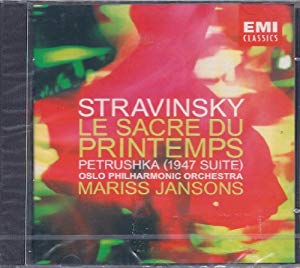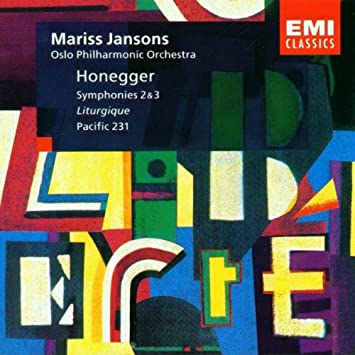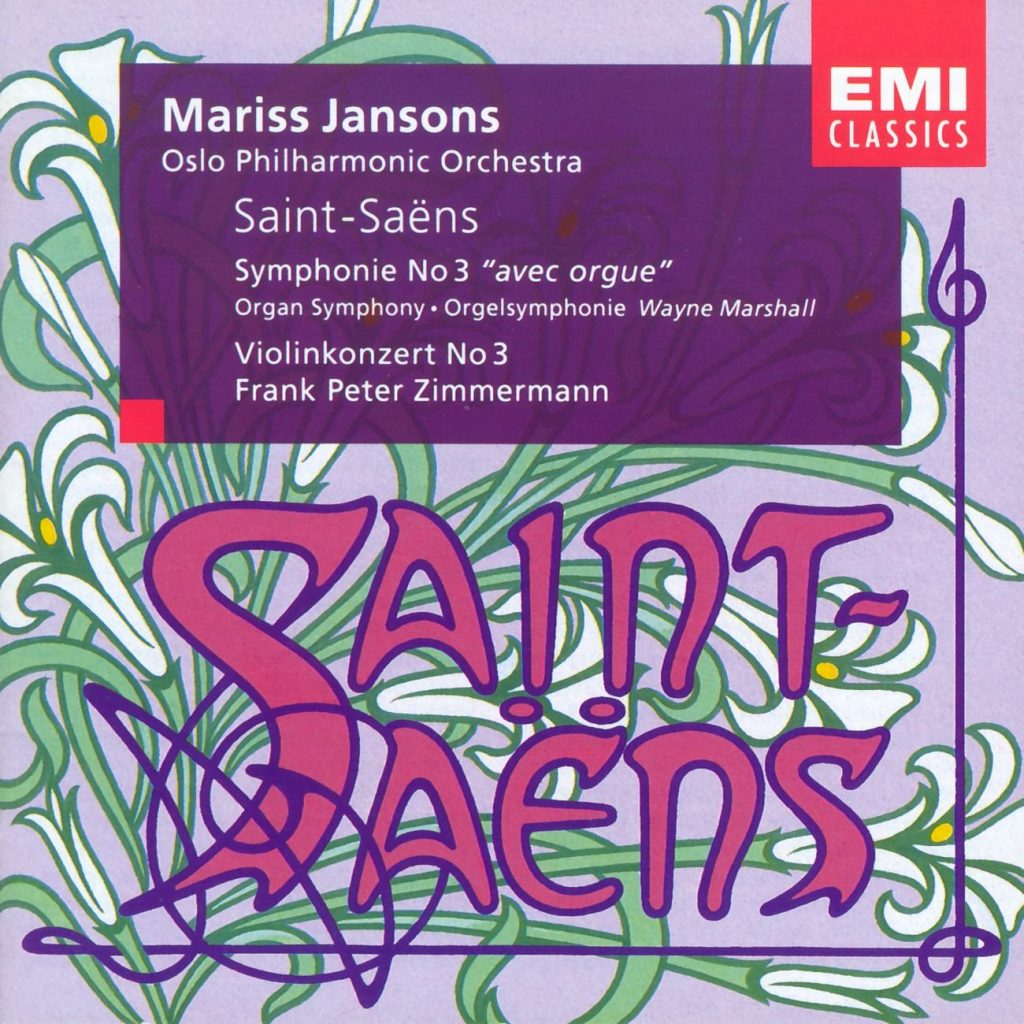Warner Classics release of all twenty one EMI Jansons/Oslo recordings plus five DVDS of selected NRK TV concert broadcast concerts

Stravinsky: Le Sacre du Printemps/Petrushka (1947 version)
This recording was the last in a busy recording year for us. The year 1992 saw Jansons and the Oslo Philharmonic record the Dvorak Seventh and Eighth Symphonies, the Dvorak Cello Concerto and Tchaikovsky Rococo Variations, and the Sibelius Second Symphony and orchestral works. This was incidentally the peak year for the orchestra in terms of recordings for EMI. Going forward, it was to be one or at most two recordings a year until the end of the contract.
It was inevitable that Jansons and the Oslo Philharmonic should record Stravinsky’s Le Sacre du Printemps and Petrushka. He had performed both works on several occasions, and these two masterpieces were becoming his “party-pieces”– works that he took on tour fairly frequently.
We had worked up Le Sacre in the early spring of 1992, playing it in concerts in Oslo and on tour, culminating in a famously exciting performance in the Musikkverein in Vienna. Petrushka was performed on several tours and concert series in earlier seasons and needed relatively little working up. Recording sessions were scheduled for late November of 1992, after the orchestra returned from a short tour to the UK in which Le Sacre was one of the principal musical offerings.
The concerts in Oslo and the tour concerts in Amsterdam,London, Birmingham and Glasgow went very well, and upon our return we began the sessions in the Oslo Konserthus. (I wished then and still wish today that it was possible to make the recordings in either Amsterdam or Birmingham. The acoustics were and are far superior.) John Fraser and Mark Vigars were again at their usual places behind the recording console and the sessions were relatively trouble-free. When the recording was released some months later, I had mixed feelings. The performances were exciting, well-played and fairly well recorded, but to my mind they were a little too closed-miked in spots, and the bass drum in particular was too dry in sound. There was no depth. The Oslo Konserthus acoustic somehow sucks a lot of the life out of a performance, particularly noticeable in recordings, and this one was no exception. Lots of good things – energy, passion and commitment -these are all there in abundance. The opening to Part II of Le Sacre has a lot of atmosphere, and the Danse Sacrale is well played. Petrushka, although given a fine performance, was also plagued by the excessive close miking. It is too dry in spots. I think it and Le Sacre could have used a little reverb to give it some more “oomph.” As it turned out, the acoustics of the venue let these performances down, and I can only give the recording a B+ at best. A for performance – B- for recorded sound – result: B+.

Honegger: Symphonies No. 2 & 3 – Pacific 231
In checking the recording dates on the back of this particular sleeve, I see that these works were recorded in November and December of 1993, fully a year after we recorded Le Sacre and Petrushka. This was in a sense, the beginning of what I call the “great slow-down” in recording for EMI. Up until this point, we had been doing at least two and sometimes three recordings a year for EMI. Over the course of the year 1992, we actually made four. In 1993, we made exactly one – this Honegger disc. At the time we recorded these works, I was not familiar with the music of Honegger other than the Third Symphony. One of the reasons is that the other works of his that the orchestra played – and they are on this disc- did not have a part for timpani, so I was not involved in either recording or performances of either the Second Symphony, which is scored for strings and trumpet, and Pacific 231, which is is scored for full orchestra, but without timpani. The Third Symphony includes a timpani part, and quite a decent one at that, so I was involved in that work. The symphony is subtitled “Liturgique“, and its three movements have Latin subheadings. The first movement is named “Dies Irae“, from the Requiem Mass; the second movement is named “De profundis clamavi” from Psalm 130 and the final movement bears the name “Dona nobis pacem“, from the liturgy of the Mass. The orchestra was quite familiar with the “Liturgique“, having performed it in concert and on tour. If memory serves me correctly, the Second Symphony and Pacific 231 were less familiar, and were “played in” as part of two different concert series performed around the recording sessions. The “Liturgique“had already been played in on previous tours and concerts, and did not need to be worked over. Our regular recording team was not available for these sessions, so our original EMI producer, David Murray was called back into service, with Michael Sheady as sound engineer. From what I can remember, all went well with concerts and recording sessions. At the time of the recording’s release, I was pleased with the result. Listening to the disc all these years later, I stand by my original positive assessment. First off, the sound is excellent. The strings in the symphonies are clear, and there is a good sense of balance. Both symphonies come off well. The Second sounds fresh and there is an intensity in the playing that keeps one’s interest. The “Liturgique” is a work that Jansons always did well, and here is no exception. It is a deeply felt performance which stands the test of time. Well played and well balanced, it is as good as his later remake with the Concertgebouw Orchestra. The second movement proceeds with the right amount of gravitas. The tempo is perfect!The build-up to the climax of the last movement is intense. Pacific 231 also gets an excellent performance – it really does sound like the steam locomotive of the same name. Our recording team for these sessions had the measure of our acoustically challenged concert hall . In my opinion, this recording gets an A on all counts. Jansons was a good interpreter of this music, and it is sad that we did not do more of it.

Saint-Saens: Symphony No. 3 “avec orgue” -Violin Concerto No. 3
This recording was one of two that Jansons and the orchestra recorded in 1994. The other recording will be discussed in the next installment of this blog post. To be honest, this recording, and the circumstances surrounding it were atypical of the way we normally went about these things, For one thing, we had two soloists – Frank Peter Zimmerman for the Violin Concerto, and Wayne Marshall at the organ for the Symphony No. 3. For another thing, we had two different producers for the recording – David Groves for the onsite recording of the concerto and symphony with Michael Sheady as engineer, and John Fraser, who did the dubbing in of the organ from the Church of St. Ouen in Rouen. Yes – that’s right – Wayne Marshall played the organ in the Konserthus for the concert, but when we recorded it, he was not present. He played the organ at St. Ouen for the dubbing sessions later. To top it off, boht Frank Peter Zimmerman and Mariss Jansons took sick during this period – the soloist was able to record the concerto with Jansons, but did not play the concert, and Jansons did the recording sessions but none of the concerts.
It was a very confusing situation, and the fact that it came off as well as it did is a minor miracle. Both works are fun to play and to listen to, and the recordings went fairly well under the circumstances, although it was strange to record the symphony without the organ.
When hearing the result, I had mixed feelings. The Violin Concerto came off well enough, and the Symphony received a very good performance, but the dubbed-in organ played by Wayne Marshall was a shock. The organ in St. Ouen is a Cavaille-Coll – with the sounds associated with those instruments. Very reedy and very French – almost too much so. It is not so much the organ itself that is the problem, but the cathedral-like acoustic. The combination of the two gave me such a shock then, and it still does. Wayne Marshall plays very well, but I have my doubts about the wisdom of dubbing it in as they did. The performance is very good, but is let down in my opinion by the organ dubbing. They should have used the organ in the Konserthus – it would have sounded more present and not like some distant, august “presence.” Also, the tempo in the final movement is a little slower than Jansons would normally have done it, as he was factoring in the dubbing process, and that robbed the performance of a little spontaneity. The performance of the concerto is excellent, which is why this record gets a B+ – if it weren’t for the dubbed-in organ, this would have been an A. I suspect that they wanted to get the sound of a Cavaille-Coll on record. In my opinion, it would have been better for the soloist make a recording of repertoire suited to the organ there, and used the Konserthus instrument for the recording. I’ve repeated myself,which shows how bothered I am still by this.
Here is the finale of the symphony. See if you don’t agree with me.

Recent Comments